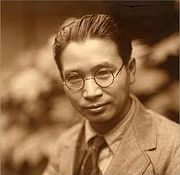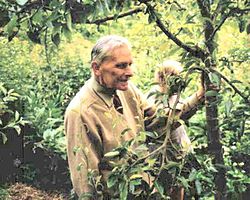Toyohiko Kagawa
From Wikipedia, the free encyclopedia
Toyohiko Kagawa

c. 1920
Born July 10, 1888
Kobe, Japan
Died April 23, 1960 (aged 71)
Nationality Japanese
Occupation Social reformer, peace activist, labor activist, evangelist, author
Spouse(s) Haru

Toyohiko and Haru

At Princeton Theological Seminary

Great Kantō earthquake, 1923

In America, 1935
Toyohiko Kagawa (賀川 豊彦 Kagawa Toyohiko, 10 July 1888 – 23 April 1960) was a Japanese Christian pacifist, Christian reformer, and labour activist. Kagawa wrote, spoke, and worked at length on ways to employ Christian principles in the ordering of society and in cooperatives. His vocation to help the poor led him to live among them. He established schools, hospitals, and churches.
Contents
1Early life
2Activism
3Health and death
4Brotherhood economics
5Three-dimensional forestry
6Legacy
7Famous quotes
8See also
9Writings
10Bibliography
11References
Early life[edit]
Kagawa was born in Kobe, Japan to a philandering businessman and a concubine. Both parents died while he was young. He was sent away to school, where he learned from two American missionary teachers, Drs. Harry W. Myers and Charles A. Logan, who took him into their homes.
Kagawa learned English from these missionaries and converted to Christianity after taking a Bible class in his youth, which led to his being disowned by his remaining extended family. Kagawa studied at Tokyo Presbyterian College, and later enrolled in Kobe Theological Seminary. While studying there, Kagawa was troubled by the seminarians' concern for technicalities of doctrine. He believed that Christianity in action was the truth behind Christian doctrines. Impatiently, he would point to the parable of the Good Samaritan.[1] From 1914 to 1916 he studied at Princeton Theological Seminary. In addition to theology, through the university's curricular exchange program he also studied embryology, genetics, comparative anatomy, and paleontology while at Princeton.[2]
Activism[edit]
In 1909 Kagawa moved into a Kobe slum with the intention of acting as a missionary, social worker, and sociologist. In 1914 he went to the United States to study ways of combating the sources of poverty.[3] In 1916 he published Researches in the Psychology of the Poor based on this experience in which he recorded many aspects of slum society that were previously unknown to middle-class Japanese. Among these were the practices of illicit prostitution (i.e., outside of Japan's legal prostitution regime), informal marriages (which often overlapped with the previous category), and the practice of accepting money to care for children and then killing them.
Kagawa was arrested in Japan in 1921 and again in 1922 for his part in labour activism during strikes. While in prison he wrote the novels Crossing the Deathline and Shooting at the Sun. The former was a semi-autobiographical depiction of his time among Kobe's destitute. After his release, Kagawa helped organize relief work in Tokyo following the 1923 Great Kantō earthquake and assisted in bringing about universal adult male suffrage in 1925.
He organized the Japanese Federation of Labour as well as the National Anti-War Leaguein 1928. Throughout this period, he continued to evangelize to Japan's poor, advocate women's suffrage and call for a peaceful foreign policy. Between 1926 and 1934 he focused his evangelical work through the Kingdom of God Movement.
In 1940, Kagawa made an apology to the Republic of China for Japan's occupation of China, and was arrested again for this act. After his release, he went back to the United States in a futile attempt to prevent war between that nation and Japan. He then returned to Japan to continue his attempts to win women's suffrage. After Japan's surrender, Kagawa was an adviser to the transitional Japanese government.
During his life, Kagawa wrote over 150 books. He was nominated for the Nobel Prize in Literature in 1947 and 1948, and the Nobel Peace Prize in 1954 and 1955.[4]
Health and death[edit]
In Osaka, March, 1955, Kagawa suffered collapse from his deteriorating heart, and remained bedridden for 2 weeks. He continued writing, preaching, overseeing projects, and hosting guests, despite concerns from his family and associates. Kagawa's condition worsened throughout the years, and he was hospitalized again, for 3 months in 1959, at Saint Luke's Hospital in Takamatsu. Kagawa remained bedridden at home for most of his time in Matsuzawa. His health gradually improved in mid-April, then worsened again. On April 23, Kagawa was unconscious for 3 hours, then woke and smiled to his wife and others around him, his last words being "Please do your best for world peace and the church in Japan."[5]
Brotherhood economics[edit]
Kagawa's economic theory, as expressed in the book Brotherhood Economics, advocated that the Christian Church, the cooperative movement, and the peace movement unite in a 'powerful working synthesis' to provide a workable alternative to capitalism, state socialism, and fascism.[6] Kagawa's work in the co-operative movement consisted of founding several consumer co-operatives in 1921, including the Co-op Kobe, Nada Consumer Co-operative (later merged with Co-op Kobe), the Kyoto Consumer Co-operative, Tokyo Student's Consumer Co-operative and Tokyo Iryou (Medical) Consumer Co-operative.[5]
Three-dimensional forestry[edit]
While studying at Princeton University, Kagawa read Tree Crops: A Permanent Agriculture by Joseph Russell Smith. Inspired by this book, he managed to persuade many of Japan's upland farmers during the 1930s that the solution to their soil erosion problem lay in widespread tree-planting.
Kagawa also advised that they could receive further benefit if they planted crop trees, such as quick-maturing walnuts, to provide feed for their pigs.[7]
The planting of fruit and nut trees on farmland aims to conserve the soil, supply food for humans and provide fodder for animals, the three "dimensions" of his system.
Kagawa was a forerunner of modern forest farming and an inspiration to Robert Hart who pioneered forest gardening in temperate climates.[7]
Legacy[edit]
After his death, Kagawa was awarded the second-highest honor of Japan, induction in the Order of the Sacred Treasure. The Evangelical Lutheran Church in Americacommemorates him as a renewer of society on April 23; Kagawa is also honored with a feast day on the liturgical calendar of the Episcopal Church (USA) on that day.
Famous quotes[edit]

This page is a candidate to be copied to Wikiquoteusing the Transwiki process. If the page can be expanded into an encyclopedic article, rather than a list of quotations, please do so and remove this message.
On the morning of 1946, at the Imperial Palace in Tokyo, before Emperor Hirohito, "Whosoever will be great among you... shall be the servant of all. A ruler's sovereignty, Your Majesty, is in the hearts of the people. Only by service to others can a man, or nation, be godlike."[citation needed]
"Communism's only power is to diagnose some of the ills of disordered society. It has no cure. It creates only an infantile paralysis of the social order."[citation needed]
"I read in a book that a man called Christ went about doing good. It is very disconcerting to me that I am so easily satisfied with just going about."[8]
"It seemed that everyone was attacking me – the Soviet Communists, the anarchists, the capitalists, the foul-mouthed literary critics, the sensationalist newspaper men, the Buddhist who could not compete with Christ, and those many Christians who profess Christ but believe in a Christianity which is sterile."[5]
See also[edit]
 Christianity portal
Christianity portal Saints portal
Saints portalList of civil rights leaders
Japanese dissidence during the Shōwa period
Writings[edit]
Love - The Law of Life. Student Christian Movement Pr., London, 1930
Meditations on the Cross. 1935. Translated by Helen Topping and Marion Draper. Chicago, New York: Willet, Clark & Company.
Bibliography[edit]
 Wikimedia Commons has media related to Toyohiko Kagawa.
Wikimedia Commons has media related to Toyohiko Kagawa.- "Unconquerable Kagawa", Reader's Digest, pp. 29–31, 1951.
- Charlie May Simon. 1958. A Seed Shall Serve – A Story of Toyohiko Kagawa Spiritual Leader of Modern Japan. New York: EP Dutton & Co.
- Kagawa, Toyohiko, Trout, Jessie M. (1960). Kagawa, Japanese prophet: His witness in life and word. New York: Association Press. WorldCat Link
- Richard H. Drummond, A History of Christianity in Japan. Grand Rapids: Eerdmans, 1971.[page needed]
- Robert Schildgen. 1988. Toyohiko Kagawa. Apostle of Love and Social Justice.Berkeley: Centenary Books.
- Toyohiko Kagawa, Japanese Original, Christian History Institute, 2001
- "Kagawa Toyohiko", Encyclopædia Britannica (online ed.), 2005.
- Kagawa Toyohiko (biography), BookRags
- Bo Tao. 2013. The Peacemaking Efforts of a Reverse Missionary: Toyohiko Kagawa before Pearl Harbor. International Bulletin of Missionary Research Vol. 37, No. 3: 171–76.
- Toyohiko, Kagawa (2014), Hastings, Thomas John, ed., Cosmic Purpose, Veritas, Cascade.
- Thomas John Hastings, Seeing All Things Whole: The Scientific Mysticism and Art of Kagawa Toyohiko (1888–1960), Pickwick Publications, 2015.
References[edit]
^ Axling,William.Kagawa.Harper and Brothers Publishers. New York and London. 1946.Chapter 3. p 28-41
^ Anri Morimoto, "The Forgotten Prophet: Rediscovering Toyohiko Kagawa," Archived2011-07-26 at the Wayback Machine. The Princeton Seminary Bulletin, Vol. 28, No. 3 (2007), 303.
^ "ٓ̔". Tv-naruto.ne.jp. Archived from the original on 4 March 2016. Retrieved 2 December2014.
^ "Nobel Peace Prize Nomination Database". Nobelprize.org. Retrieved 2 December 2014.
^ Jump up to:a b c Schildgen, Robert, "Toyohiko Kagawa", California: Centenary Books, 1988
^ Kagawa, Toyohiko, “Brotherhood Economics”, New York and London: Harper & Brothers, 1936.
^ Jump up to:a b Robert Hart (1996). Forest Gardening. p. 41.
^ Kabelitz, Norb (2010). ""Cross" fertilization: Third Sunday in Lent". Chesterfield, MO: The Crossings Community, Inc. Archived from the original on 16 April 2010. Retrieved 2 May2018.
hide
v
t
e
Cooperatives and mutual organizations
show
Types of cooperatives
show
Topics
History of the cooperative movement
.coop
-------------
賀川豊彦
| 賀川 豊彦 | |
|---|---|

若き日の賀川豊彦
| |
| 生誕 | 1888年7月10日 |
| 死没 | 1960年4月23日(71歳) |
| 職業 | 社会運動家、牧師、議員 |
| 配偶者 | 賀川ハル |
| キリスト教社会主義 |
| 社会的キリスト教 |
|---|
 |
| 起源 |
| アッシジのフランチェスコ ケテラー 教皇レオ13世 · コルピンング エドワード・ベラミー M・W・ベン ベリーマン · J・H・コーン ドロシー・ディ · アントニオ・ネグリ レフ・トルストイ · オスカル・ロメロ グスタボ・グティエレス · A・カイパー D・ベリガン · P・ベリガン キング牧師 W・ラウシェンブッシュ デズモンド・ツツ · トミー・ダグラス 賀川豊彦 · 村井知至 · 中島重 |
| 組織 |
| 日本キリスト教協議会 |
| 概念 |
| 補完性原理 · 無政府主義 人文主義 · マルクス主義 キリスト教共産主義 · 自由主義神学 キリスト教社会主義 · 社会正義 黒人自由主義神学 プラクシス学派 · プレカリアート 人間の尊厳 · 社会的市場経済 共同体主義 · 私有財産分配論 カトリック社会教説 新カルバン主義 · 新トミズム 集中の法則 監督の店舗 |
| 書物 |
| レールム・ノヴァールム (1891) プリンストン神学校 (1898) 人口増加 (1967) 百年紀 (1991) カリタス・イン・ベリタテ (2009) |
7月10日 - 1960年(昭和35年)4月23日)は、大正・昭和期のキリスト教社会運動家、社会改良家。戦前日本の労働運動、農民運動、無産政党運動、生活協同組合運動において、重要な役割を担った人物。日本農民組合創設者。「イエス団」創始者。キリスト教における博愛の精神を実践した「貧民街の聖者」として日本以上に世界的な知名度が高い。茅ヶ崎の平和学園の創始者である。
略歴・人物[編集]
兵庫県神戸市に、回漕業者・賀川純一と徳島の芸妓・菅生かめの子として生まれる。幼少期に相次いで父母と死別して、5歳の時姉と共に徳島の本家に引き取られるも、兄の放蕩により15歳の時に賀川家は破産してしまい、叔父の森六兵衛の家に移る。旧制徳島中学校(現在の徳島県立城南高等学校)に通っていた1904年(明治37年)、日本基督教会徳島教会にて南長老ミッションの宣教師H・W・マヤスより受洗。この頃安部磯雄・木下尚江の著作を読み、キリスト教社会主義に共感を覚える。また『戦争と平和』に代表されるトルストイの反戦思想にも影響を受け、軍事教練サボタージュ事件を起こす。伝道者を志し、1905年(明治38年)に明治学院高等部神学予科に入学、卒業後の1907年(明治40年)、新設の神戸神学校(のちの中央神学校)に入学する。
社会事業家として[編集]
結核に苦しみ、また信仰への懐疑に煩悶(はんもん)しながら、やがて「貧民問題を通じて、イエスの精神を発揮してみたい」と一念発起し、1909年(明治42年)神戸市新川のスラムに住み込み、路傍伝道を開始する。1911年(明治44年)に神戸神学校を卒業、1912年(大正元年)には一膳飯屋「天国屋」を開業した。
女工のハルと貧民窟で出会い、1913年(大正2年)に神戸の教会で簡素な結婚式を挙げた。ハルは15歳で下女となるために上京した女性だった。賀川は貧民窟で下層の貧民らを招いて豪華な披露宴を行って、下層民たちにご馳走をふるまい、妻ハルを紹介して言った。「私はみなさんの女中をお嫁にもらいました。あなた方の家がお産や病気で手が足らなくて困った時には、いつでも頼みに来てください。喜んで参ります」[1]。
1914年(大正3年)に渡米し、アメリカの社会事業、労働運動を垣間見[2]プリンストン大学・プリンストン神学校に学び、1915年(大正4年)にスラムでの経験を踏まえて『貧民心理之研究』を出版する。賀川はこの「穢多村の研究」で、犯罪の多い部落民が異人の子孫であるという人種起源説を主張した。のちに、文中に差別思想があるとして部落解放運動関係者から批判されている。
1917年(大正6年)に帰国すると、神戸のスラムに戻り無料巡回診療を始めた。また、米国留学中の体験から貧困問題を解決する手段として労働組合運動を重要視した賀川は、鈴木文治率いる友愛会に接触し、1919年(大正8年)に友愛会関西労働同盟会を結成、理事長となった。同年日本基督教会で牧師の資格を得、麹町教会の牧師になる。
1920年(大正9年)に自伝的小説『死線を越えて』を出版、一大ベストセラーとなり、賀川の名を世間に広めた。印税はほとんど関与した社会運動のために投じられた。また同年、労働者の生活安定を目的として神戸購買組合(灘神戸生協を経て現・コープこうべ=日本最大の生協)を設立、生活協同組合運動にも取り組んだ。また、武藤富男らと共に、キリスト教系業界紙、キリスト新聞(発行元:キリスト新聞社)を立ち上げた。
1921年(大正10年)、神戸の三菱造船所(現・三菱重工業神戸造船所)・川崎造船所(現・川崎造船神戸工場)における大争議を指導するも、会社側の強硬な対応により敗北を喫し、これを契機に関西の労働運動において急進的なサンディカリストの勢力が増していった。賀川はやがて農民運動に活躍の場を移すことになる。また、関東大震災の被災者救済をきっかけに本所基督教産業青年会を発足[3]、貧民診療所などを経営した[4]。
1922年(大正11年)、協力者・杉山元治郎とともに日本農民組合を設立し、本格的に農民運動に取り組んだ。組合は急速に発展し、3年後の1925年(大正14年)末には組合員数は7万人を超えた。この間、1923年(大正12年)に関東大震災罹災者救済活動を行う。また無産政党運動にも積極的に関与し、1926年(大正15年)の労働農民党結成に当たっては執行委員に就任するが、同年末の左右分裂に際して党を脱退した。
1920年代後半以降は、社会運動から宗教活動へと比重を移していった。1925年(大正14年)に同志社大学で講義を行い中島重に影響を与え友誼を結ぶ。1929年(昭和4年)、日本基督教連盟の特別協議会は賀川の主導により「神の国運動」を議決、賀川は「百万人の救霊」を目標として、1932年(昭和7年)まで全国を伝道のため巡回した。また米国・中国・欧州等世界各国で講演活動を行う。1941年(昭和16年)4月、リバーサイド日米キリスト者会議でアメリカ合衆国のキリスト教会に「アメリカ教会への感謝状」をおくった。
第二次世界大戦に関しては「国際戦争反対者同盟」に属したが、1943年(昭和18年)11月の憲兵隊による取調べを境に同同盟を脱退、「国際友和会日本支部」を自ら解散している。太平洋戦争(大東亜戦争)後期において(一説には太平洋戦争当初から)、多くの宗教家と同じく戦争に協力的な姿勢であった。終戦(敗戦)により中止となったが、1945年(昭和20年)8月16日には賀川も奨励者として名を連ねる「戦意昂揚音楽礼拝」が「日本基督教団戦時活動委員会」の主催により予定されていた。
政治家として[編集]
戦後は東久邇宮内閣参与や勅選貴族院議員を務め、日本社会党の結成にも参画した。民間人として初めてマッカーサーに会った人物であるとされている。終戦直後の目立った活動としては「一億総懺悔運動」への協力が挙げられる。マーク・ゲイン著『ニッポン日記』によると、東久邇宮稔彦王の後任首相として有力であったらしいが、戦時中の翼賛的な活動が原因で実現しなかったとのことである。同書には、一般に知られる賀川の人物像とかなり食い違う姿が記されており、またそこで書かれている様な賀川への批判が連合国軍総司令部 (GHQ) により封じられていたともある。幣原内閣解散後の吉田内閣組閣の難航に伴い、総理大臣候補として名が挙がったこともあるという。晩年は世界連邦運動に取り組み、1947年(昭和22年)と翌1948年(昭和23年)にはノーベル文学賞の候補となり(1947(昭和22)年は候補48人中、1948(昭和23)年は候補45人中)[5]、 1954年(昭和29年)から1956年(同31年)の3年連続でノーベル平和賞候補者として推薦された[6]。
大宅壮一によると、賀川はクリスチャンかつ労働運動・社会運動の指導者的立場ながら、昭和天皇・皇室の熱烈な支持者でもあり、日本社会における天皇(天皇制)の存在意義を積極的に認めていたという。日本社会党結党の際には、中間派の浅沼稲次郎らと共に中心メンバーとなり、結党大会で「天皇陛下万歳」三唱の音頭を取ったことで、社会党左派との内部対立を引き起こした。
エピソード[編集]
- 自身が結成した日本MTLを率いてハンセン病患者への宣教と慰問を中心に活動していたが、やがて、優生学に傾倒しハンセン病患者の淘汰を目的とした無癩県運動へと活動の重点を移していった[7]。
- また、夜の仕事に就く女性、就かざるを得ない女性に対しても、女性差別的な持論を展開している。連合国軍占領下の日本において米兵による婦女子の強姦事件が多発していた頃、『婦人公論』1947年8月号で「闇の女に堕ちる女性は、多くの欠陥を持っている」とし、パンパンについては「わざと悪に接近」するような悪魔的なところがあり、「一種の変成社会における精神分裂病患者である」と指摘した[8]。
- 墓は東京都の多磨霊園にある。
- ワシントン大聖堂には、日本人として新島襄とともに彫像が掲げられている。
- 1947、48(昭和22、23)年には、ノーベル文学賞の候補に選ばれたことがある[9]。
著書[編集]
- 『貧民心理の研究』(警醒社書店、1915年)
- 『死線を越えて』(改造社、1920年)
- 『地殻を破って』(福永書店、1920年)
- 『主観経済の原理』(福永書店、1920年)
- 『生存競争の哲学』(改造社、1922年)
- 『空中征服』(改造社、1922年)
- 『一粒の麦』(大日本雄辯會講談社、1931年)
- 『人格社会主義の本質』(清流社、1949年)
- 『賀川豊彦全集』(キリスト新聞社、1962年~1964年)
記念事業[編集]
2009年(平成21年)、関連団体が実行委員会を組織し、「賀川豊彦献身100年記念事業」が行われている。
参考文献[編集]
- 中村敏『著名人クリスチャンの結婚生活』(ファミリー・フォーラム・ジャパン)
脚注[編集]
- ^ 『著名人クリスチャンの結婚生活』
- ^ 木原活信「賀川豊彦とジェーン・アダムズ-セツルメントをめぐって-」賀川豊彦記念松沢資料館『雲の柱』第15号,pp.8-12.1998参照
- ^ 法人の概要 本所賀川記念館の沿革本所賀川記念館
- ^ 大野博士事件『明治・大正・昭和歴史資料全集. 犯罪篇 下卷』有恒社、1932-1934
- ^ The Nomination Database for the Nobel Prize in Literature, 1901-1950 1948年(昭和23年)の推薦者は探検家として有名なスヴェン・ヘディンである。
- ^ The Nomination Database for the Nobel Peace Prize, 1901-1950
- ^ 藤野豊『近代日本のキリスト教と優生思想』
- ^ 恵泉女学園大学平和文化研究所 『占領と性』 p.161-162
- ^ “賀川豊彦:ノーベル文学賞候補だった 1947、48年連続--日本人初”. mainichi.jp (毎日新聞社). (2009年9月13日). オリジナルの2009年9月23日時点によるアーカイブ。
関連項目[編集]
- 世界連邦運動
- 日本社会党
- 賀川記念館 - 神戸市中央区(旧葺合区の方)吾妻通に、神戸イエス団教会(日本基督教団)と友愛幼児園(かつて日本軍が幼稚園への改称を迫るも、賀川はあくまでもこの名称にこだわったという逸話が残る)との併設。2009年12月、改築竣工。近くの生田川公園内には、生誕100年記念のモニュメントがある。
- 賀川豊彦記念・松沢資料館
- 鳴門市賀川豊彦記念館
- NPO法人賀川豊彦記念・鳴門友愛会
- 財団法人雲柱社
- 神戸文学館
- 加藤剛 - 実写映画『日本侠花伝』(1973年11月17日公開東宝製作)で、賀川を演じた。
- 国広富之 - 実写映画『死線を越えて 賀川豊彦物語』(現代ぷろだくしょん製作)で、賀川を演じた。
関連文献[編集]
- 武藤富男『評伝賀川豊彦』キリスト新聞社、1981年。
- 隅谷三喜男『賀川豊彦』(岩波書店 ISBN 4002602451 1995年)
- マーク・ゲイン『ニッポン日記』筑摩書房〈ちくま学芸文庫〉、1998年。
- 林啓介『賀川豊彦―阿波の偉人伝』阿波銀行、2000年。
- 雨宮栄一『青春の賀川豊彦』新教出版社、2003年。
- 雨宮栄一『貧しい人々と賀川豊彦』新教出版社、2005年。
- 雨宮栄一『暗い谷間の賀川豊彦』新教出版社、2006年。
- 滝川好夫『資本主義はどこへ行くのか』(PHP研究所 ISBN 978-4569705798 2009年1月) - 賀川豊彦の思想・経済学をベースに「道徳経済」を提唱している。
- 小南浩一『賀川豊彦研究序説』緑蔭書房、2010年。
外部リンク[編集]
 ウィキメディア・コモンズには、賀川豊彦に関連するカテゴリがあります。
ウィキメディア・コモンズには、賀川豊彦に関連するカテゴリがあります。賀川 豊彦:作家別作品リスト - 青空文庫
賀川豊彦とその仲間たちの事業展開(PDF)
賀川記念館(神戸)
財団法人雲柱社 賀川豊彦記念・松沢資料館
社会福祉法人雲柱社
学校法人雲柱社松沢幼稚園
NPO法人賀川豊彦記念・鳴門友愛会 鳴門市賀川豊彦記念館
社会福祉法人・学校法人 イエス団
一麦保育園
財団法人 国際平和協会
世界連邦運動協会
世界連邦運動協会 日本の世界連邦運動
キリスト新聞社
財団法人本所賀川記念館
中ノ郷信用組合
全労済のあゆみ
日本生協連の歴史
生活協同組合コープこうべ
コープこうべ協同学苑資料館
社会福祉法人聖隷福祉事業団
イエスの友会
日本農民組合 apedia








